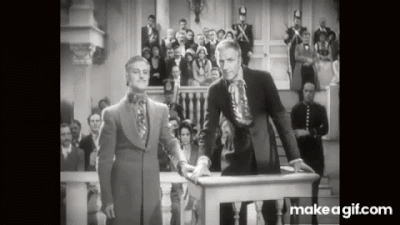
I have seen only two versions of Alexandre Dumas père's 1845 novel, "The Count of Monte Cristo" in my past - the 1975 television version with Richard Chamberlain and the 2002 Disney film with James Cavielzel. While reading a good number of articles about the movie versions of the novel, I came across numerous praises for the 1934 adaptation that starred Robert Donat. And since I happened to like Dumas' story so much, I decided to see how much I would like this older version.
Set between the last months of the Napoleonic Wars and the 1830s, "THE COUNT OF MONTE CRISTO" told the story of merchant sailor Edmond Dantès becomes a victim of French political machinations and personal jealousy after his dying captain Leclère, a supporter of the exiled Napoléon I, charges him to deliver a letter from the exiled former emperor to an unknown man in Marseilles. Thanks to the first mate Danglars, who is jealous of Dantès' rapid rise to captain; an ambitious city magistrate named Raymond de Villefort, Jr., who wants to stem a possible family scandal, due to his father being identified as the man to whom Napoléon had written the letter; and his best friend Fernand Mondego, who is in love with Dantès' fiancée, Mercedes de Rosas; Dantès ends up on an island prison called Château d'If. There, he meets a fellow prisoner, a priest and a former soldier in Napoleon's army named Abbé Faria. Faria educates Dantès and informs the latter a fabulous hidden treasure before he is killed in a cave-in. Dantès escapes from the prison and befriends a group of smugglers that include a thief named Jacopo. They find the treasure that Faria had talked about, and Edmond uses it to establish the persona of the Count of Monte Cristo. He hopes to avenge himself against those who had betrayed him – Danglars, Villefort, Mondego. He also learns that Mercedes had married Mondego not long after his imprisonment.
Many critics have labeled this movie as the best adaptation of Dumas' novel. Is it the best? It all depends on individual preference. I do know that I enjoyed "THE COUNT OF MONTE CRISTO" very much. The movie benefited from solid writing by director Rowland V. Lee, Philip Dunne and Dan Totheroh, despite some of the changes they made from the novel. "THE COUNT OF MONTE CRISTO" benefited from a script that balanced action with drama. I found it interesting that most of the action occurred in the movie's first half - before Dantès' transformation into the Count of Monte Cristo. Aside from a brief duel between Dantès and Mondego, most of the second half seemed dominated by drama and Dantès' schemes. My favorite scheme centered around Dantès' exposure of Mondego's murderous actions against I have no problem with this . . . to a certain extent. One of the major differences between this movie and Dumas' novel is the romance between Dantès and Mercedes. Unlike the novel, the pair eventually reconcile with each other, following the death of Mercedes' husband. Frankly, I am glad that Lee and the other two screenwriters made this change. As much as I admired Dumas' bittersweet ending to Dantès and Mercedes' relationship, I have always found it somewhat . . . disappointing. That disappointment was eliminated when the screenwriters allowed the couple to spend their remaining years together.
However, I do have my complaints regarding "THE COUNT OF MONTE CRISTO". Although the movie seemed to be balanced between action and drama, I would have preferred if that balance had been maintained throughout the film. If it were not for Dantès' schemes against his enemies - especially Fernand Mondego - I would have been bored with the movie's second half. It did not help that I found Dantès' duel with Mondego rather dull. Even worse, the screenwriters decided to be faithful to Dumas' novel by having the duel before Dantès' acts of vengeance against Danglars and de Villefort. For once, I wish they had not been so faithful. And honestly . . . I wish the screenwriters had found another way for Dantès to exact revenge upon de Villefort other than prematurely exposing himself . . . an act that led to his arrest and trial. Because I did not find this method particularly satisfying.
I certainly have no complaints about the performances in "THE COUNT OF MONTE CRISTO". There were performances that I found solid, but not particularly interesting. Among them are Irene Harvey and Douglas Walton as the two young lovers - Valentine de Villefort and Albert Mondego; Luis Alberni as Jacopo; Lawrence Grant as a slightly hammy de Villefort Sr.; and Georgia Caine as Mercedes' mother. Louis Calhern, Sidney Blackmer and Raymond Walburn as Dantès' three nemesis - Raymond de Villefort Jr., Ferdinand Mondego and Baron Danglars. I was especially impressed by Calhern's subtle performance. And I was very impressed by O.P. Heggie's emotional, yet wise take on the Abbé Faria. However, Robert Donat and Elissa Landi gave, in my opinion, the best performances in the film. For me, they were the heart and soul of "THE COUNT OF MONTE CRISTO". Both Donat and Landi managed to skillfully develop their characters from the innocent young lovers to the embittered ex-convict and his long-suffering former fiancée, who young lives had been unraveled by the capriciousness of three men. One of my favorite scenes in the movie featured their reunion after nearly twenty years apart. I found it both tense and emotionally satisfying.
There are some aspects of "THE COUNT OF MONTE CRISTO" that prevents it from becoming a big favorite of mine. But I cannot deny that it is a well-made adaptation of Dumas' novel. And one can thank Rowland V. Lee's solid direction, the excellent script written by him, Philip Dunne and Dan Totheroh, and a solid cast led by the talented Robert Donat.


















































